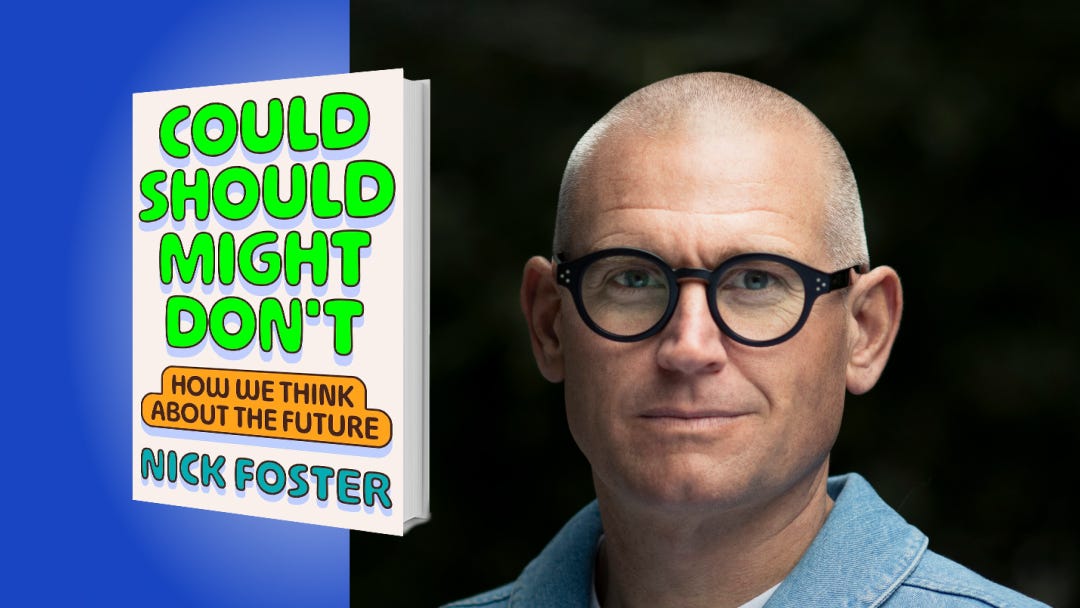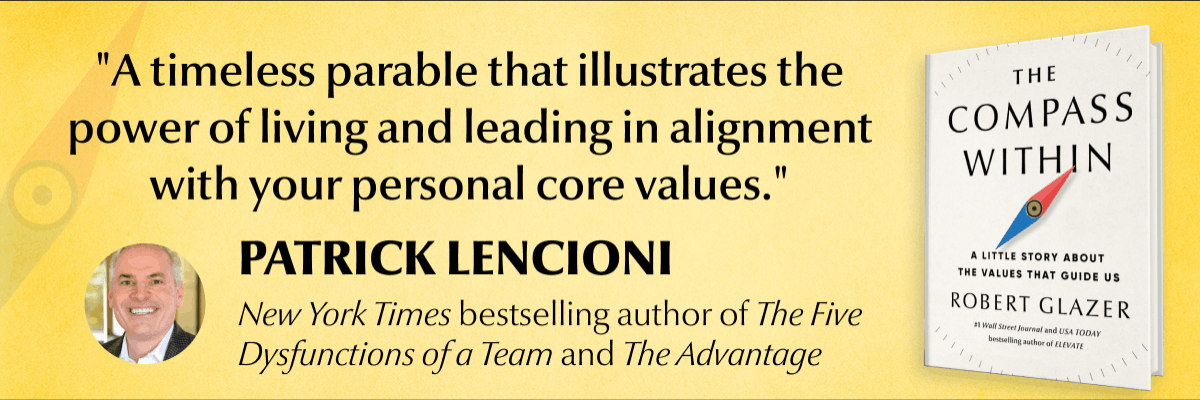The 4 Ways We Get the Future Wrong
Why our obsession with forecasts blinds us to what’s actually possible.
Listen now on Spotify or Apple Podcasts:
AI is writing poems. Vehicles are driving themselves. It’s easy to think the future is already here—but it’s not. There’s much more coming. The question is: what kind? Flying cars and robot lovers? Social and environmental collapse?
Nick Foster, a designer who’s worked with Apple, Dyson, and Google X, says our problem isn’t what’s coming next—it’s how we think about it. His new book, Could Should Might Don’t: How We Think About the Future, shows why better imagination leads to better outcomes. Read on for his key insights and get a copy for yourself on Amazon.
1. Thinking about the future is more important than ever.
There is a palpable sense of curiosity, uncertainty, and anxiety about the future. Google searches for What will the future be like? have tripled since 2020. I think that’s because we have experienced more change in the last hundred years than at any other time in history.
A hundred years ago, we had not yet invented penicillin, and less than half the homes in America had electricity. My father, who lived in the UK, has experienced both a world before the creation of vinyl albums and after the creation of ChatGPT. Even if I think about myself, there were half as many people on Earth when I was born as there are today.
Much of this rapid change has come with baggage, and many of the things we’re trying to fix today are the result of insufficient thought about the future from previous generations. This needs to change. To start, we need to have a conversation about our ability to think about the future.
I see the world through a design lens, but I’ve spent my entire career around entrepreneurs, scientists, engineers, strategists, investors, business leaders, and policymakers, and it seems that no one is very good at thinking about the future. This skill is significantly underprioritized, underfunded, and underdeveloped in almost all of us. Our thinking about the future tends to fall into one of four main varieties: could, should, might, don’t.
2. Could Futurism.
Could Futurism is a way of thinking about the future with wide-eyed optimism. This is probably the most familiar and publicly embraced type of futurism. If you type “futuristic” into Google images, you’ll see over-the-top visions of flying cars, humanoid robots, and towering glass architecture. This is the kind of stuff you see from futurists on conference stages or when futurists are invited onto TV, and this is also how we typically experience the future when we go to things like trade shows or expos. This futurism is built around the modernist idea of growth and change through strident progress, mechanization, and industrialism. This way of thinking about the future has largely grown in parallel with the growth of science fiction, which has fed ideas into the minds of powerful leaders. It’s exciting, escapist, and intended to shock.
“This futurism is built around the modernist idea of growth and change through strident progress, mechanization, and industrialism.”
But Could Futurism has weaknesses that are often overlooked. Just like sci-fi storytelling, this kind of futurism is heroic. It treats the future as a world filled with extreme characters having extreme experiences in extreme places—and often treads a bit closer to advertising than truth. It encourages us to think of the future as a place of extreme transformation, but doesn’t talk about transition or interstitial change. While it prides itself on imagination, Could Futurism is also incredibly repetitive, as evident in those Google search results. This futurism represents a placeholder for deep thinking, offering simplified icons that we can drop into our slideshows and conversations. It lacks genuine, rigorous consideration.
This week, Book of the Day is brought to you by Robert Glazer, an award-winning CEO, and #1 Wall Street Journal bestselling author. The Compass Within: A Little Story About The Values That Guide Us is a powerful business parable that uses fictional storytelling to share a framework to help readers identify and live by their personal core values. Book of the Day members can get Robert’s companion course for free with their purchase—just buy a hardcover copy and register your purchase here.
3. Should Futurism.
Should Futurism is focused on finding some sort of certainty and assuredness in the future. In the olden times, this was mostly built around things like soothsaying and predictions by people like Nostradamus or cutting open the belly of a goat and interpreting the shape of the entrails that fell out. This futurism can help us narrow down the future and concentrate on one dot that lies ahead.
In contemporary society, the world of Should Futurism is mostly dominated by corporate strategy. It is built on the idea that we can somehow take data from the past and convert that solid line into a dotted line that leads us to a position in the future. Though often useful, the downfall of this thinking is that we are creating pieces of well-styled, well-executed numeric fiction. Those dotted lines on charts are not real facts. Once the solid line turns into a dotted line, it ceases to be data and becomes a story.
You’ll often find people in the world of Should Futurism making bold predictions or statements about things that are “definitely” going to happen. They love that quote from Wayne Gretzky about skating to where the puck will be. But knowing where the puck will be is essentially a story. This type of thinking tends to view the world as a system that can be decoded, converted into an algorithm, and then utilized to create simulations. But anybody who’s put any money into the stock market knows that the dotted line heading into the future is just a story. Our world is volatile, stochastic, and ultimately unmappable. The idea of using historical patterns to project futures is remarkably unreliable. To use an acronym from the Army, our world is VUCA: volatile, uncertain, complex, and ambiguous.
4. Might Futurism.
Might Futurism emerges from the idea of plotting multiple scenarios out into the future, kind of like chess. This thinking is embedded, to an extent, in all of us whenever we’re planning an event or thinking through eventualities. But Might Futurism became more formalized around the Cold War with organizations like the RAND Corporation and people like physicist Herman Kahn. It was also grown upon by people like Pierre Wack, who worked for Royal Dutch Shell, trying to run scenarios for the future of their business.
“The problem with Might Futurism is it can get tangled up in jargon and diagrams that provide countless possibilities but no real answers.”
In today’s world, this is referred to mostly by the term strategic foresight, and it’s probably one of our most popular modern forms of futurism. It has an awful lot of methodologies, matrices, diagrams, and techniques for thinking about the future as a series of decision trees.
The problem with Might Futurism is it can get tangled up in jargon and diagrams that provide countless possibilities but no real answers. It’s also not very good at imagining things. We often think that certain things are ridiculous or unlikely, but just look at companies like Blockbuster, Nokia, and Kodak, which didn’t anticipate what was coming for them in the future. Or, if they did, put them in the realm of near impossibility. That’s how our brains work. That’s why when we watch things like magic and illusions, they fill us with wonder. Imagining what might happen in the future and building a sufficiently broad number of scenarios is extremely difficult.
5. Don’t Futurism.
Don’t Futurism is focused on what might go wrong or things that we don’t want to do. We may refer to these things as dystopian. Fear is a potent storytelling technique, which is why fairy tales and rhymes often focus on what might go wrong if we choose the wrong path. We also see this in oppositional democratic politics, where you have a position of power and a party that’s in opposition, who are there to point out the mistakes that might happen if we follow the rules of what’s been put in place by the leading power. It’s also found at the center of things like protests. There is a more nuanced form of Don’t Futurism emerging today, which focuses on the externalities and implications of the things we’re bringing about in the world, such as how new services and technologies we embed in society will age.
The problems with Don’t Futurism are numerous. They force us into oppositional, divided factions. They’re often polemic and call for immediate and often impossible action. And they don’t integrate well with the people or industries they want to change. Don’t Futurism is difficult because it often wants to be. Finding a balance between don’t ideas and actionable change can be tricky.





The future is always coming. Not futurism, which implies a system of answers. The future is unknown. The future is joyful and mysterious. The future is about asking and holding questions. The root of the word question is quest. Consider questions like -- What do I long to do next? How can I serve the world? Again, the future is always unfolding. Consider -- "Be here now" (Ram Dass). Feel what is going on right now.